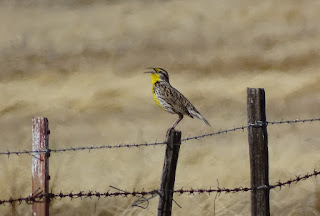Red-tailed Hawk (Buteo jamaicensis) Juvenile
Searching for hawks brought me to the desert once again. Every year thousands of Swainson's Hawks (Buteo swainsoni) migrate through the desert in Borrego Springs. Hal Cohen co-founded the official Borrego Springs Hawkwatch to record these magnificent birds each year 19 years ago. As with any bird sighting, there are no guarantees on what you may see. If you keep your eyes open, you may even get some unexpected surprises of some sort.
Hal Cohen and observer
It all starts in the evening. Scouts go out looking for the descending hawks at sunset. When they arrive, they roost in tamarisk or date trees. Most often, there are some migrating Turkey Vultures (Cathartes aura) in the roost trees as well. If the numbers are over 100, Hal will send followers an alert for those who want to take a chance to see these beautiful hawks take flight in the morning.
2017 Wildflower Bloom
2017 White-lined Sphinx Moth caterpillar
In years when there is sufficient winter rainfall, wildflowers and caterpillars cover the desert floor. In these years, the migrating hawks take advantage of this bountiful food and fill up before they continue their long journey. Some of these Swainson's Hawks travel up to 5,000 miles from Argentina northward to Canada. Due to the low precipitation this year, there are very few wildflowers and insects so the hawks have been continuing their journey after a short stay before resuming their migration path.
Kettle by Rich Shutler
Swainson's Hawks by Randy Lenon
Early in the morning, the official counters, scouts, observers and others who are just plain curious show up to watch. While I was there, a few different kettles of spiraling upward hawks and vultures appeared in the distance. Once they start to stream, head out towards the canyon in a straight path, the counting begins. I was in charge of counting vultures - 81. On this morning, over 250 Swainson's hawks were counted. It was quite a spectacle to view! Over 5400 hawks have passed through Borrego Springs this season. The official watch days will be ending in mid-April.
To read up more on the hawk watch or to join the alert, go to Hal's blog at
Beavertail Cactus
When the hawk watching was over, I was off looking for some more birds.
Sometimes you get lucky and the birds show up at your campsite.
Black-throated Sparrow (Amphispiza bilineata)
That's what happened with this singer. As you can tell by the video, it was an extremely windy camping trip.
Wild Turkey
I love the unexpected. This turkey was definitely a surprise for me! I had to stop the car for this one.
The rainbow on my final day was a perfect way to end the hawk searching trip.
Keep your eyes to the skies! A lot of action is taking place now!
Click on photos to enlarge.
Photos and content by Robin Roberts, Randy Lenon, and Richard Shutler.


































